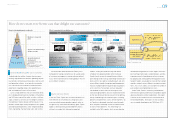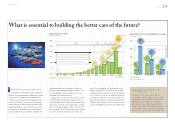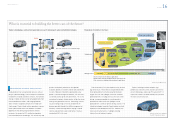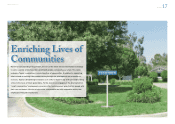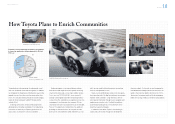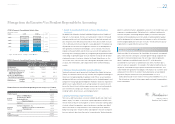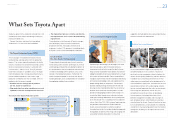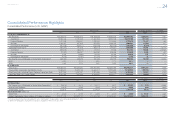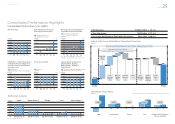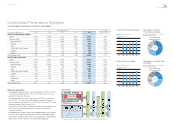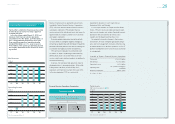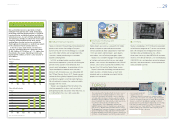Toyota 2013 Annual Report Download - page 19
Download and view the complete annual report
Please find page 19 of the 2013 Toyota annual report below. You can navigate through the pages in the report by either clicking on the pages listed below, or by using the keyword search tool below to find specific information within the annual report.
Toyota Global Vision President’s Message Launching a New Structure Special Feature Review of Operations
Consolidated Performance
Highlights
Management and
Corporate Information Investor InformationFinancial Section
Page 19
NextPrev
ContentsSearchPrint
ANNUAL REPORT 2013
Toyota aims to be a good corporate citizen, and contrib-
utes to society through a range of unique projects. From
global perspectives, we channel our energies toward
key fi elds, such as the environment, traffi c safety, and
human resource development. In Japan, we place
considerable emphasis on society and culture and have
been recognized for our efforts. We received the 2012
Mécénat Award for Supporting Hearts in recognition of
our efforts under the Company’s Kokoro Hakobu Project,
which aims to support reconstruction and revitalization
efforts in disaster-stricken areas. Organized by the
Association for Corporate Support of the Arts, the
award presented to the Company was specifi cally for
a major tipping point for us. The earthquake and its
aftermath made us realize the considerable amount of
time a full recovery requires, and we asked ourselves
what we could do on a more permanent basis to work
with and support society. We realized that we could best
help the region by expanding local manufacturing activi-
ties, which, in turn, led to the establishment of TMEJ.
Moreover, we have launched the Factory Grid (F-Grid)
Concept, which aims to facilitate safe, responsible, and
comfortable lifestyles. Spearheaded by TMEJ, the proj-
ect will create a smart community through comprehen-
sive energy management that encompasses the entire
industrial area as well as the surrounding area. Under
the F-Grid Concept, efforts will be made to secure an
energy self-suffi ciency ratio of approximately 70%.
Compared with industrial complexes of a similar size
the support activities carried out in the immediate after-
math of the Great East Japan Earthquake.
Since its foundation, Toyota has worked diligently to
uphold the principle of contributing to society by making
ever-better cars. In an effort to position the Tohoku
region as the Company’s third major production base in
Japan after the Chubu and Kyushu regions, Toyota
established Toyota Motor East Japan, Inc. (TMEJ). The
Aqua, Japan’s top-selling hybrid hatchback in fi scal
2013, is manufactured by TMEJ. Of the approximately
8,700,000 vehicles produced by Toyota worldwide in
fi scal 2013, around 500,000 were produced in the
Tohoku region, and TMEJ is becoming a major compact
car production center and exporter.
The Great East Japan Earthquake, which devastated
the Tohoku region of Japan on March 11, 2011, was
and scale, the F-Grid is expected to achieve energy
savings of 20% and reduce emissions by nearly 30%.
The project also aims to provide electricity (together with
local power companies) to the local community during
emergencies. Hybrid vehicles such as the Aqua and
Prius can also generate and store power.
By leveraging its manufacturing strengths, Toyota
intends to position its factories at the heart of its efforts
to reenergize communities and provide society with
unique and innovative services. Moving forward, Toyota
will continue to contribute to local communities though
conscientious manufacturing.
INSIGHT We see the global environment as a core customer
INSIGHT A crisis is emerging in one of the world’s most forested countries
Contributing to Society through the Manufacture of Cars
Energy fl ow:
Normal conditions
Electricity Heat
Emergency conditions
Electricity
The Toyota East
Japan
Technical
Skills
Academy
Supporting the swift recovery of
local communities during emer-
gencies using a variety of facili-
ties and devices, including solar
panels, storage batteries, and
satellite phones
Mobile power source
during emergencies
The F-Grid Concept
Artist’s depiction of a factory and industrial complex based
on the F-Grid Concept
The Kokoro Hakobu Project—
An initiative that supports disaster-stricken areas
Making Ever-Better Cars Enriching Lives of Communities [3 of 3] Stable Base of Business
The Toyota East Japan Technical Skills Academy,
an in-house training facility established to
strengthen manufacturing capabilities in the
Tohoku region
INSIGHT The “F-Grid” shows us what future communities could look like
INSIGHT Cars will change the lifestyles of the future


